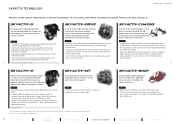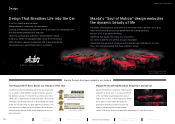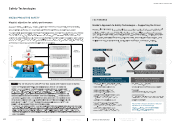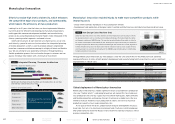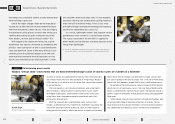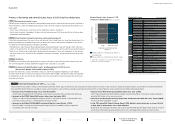Mazda 2016 Annual Report Download - page 26
Download and view the complete annual report
Please find page 26 of the 2016 Mazda annual report below. You can navigate through the pages in the report by either clicking on the pages listed below, or by using the keyword search tool below to find specific information within the annual report.
Design Divisions Manufacturing Divisions
According to Chief Designer Masashi Nakayama:
“When we explained to the related departments the
design we were seeking to develop, we repeatedly
asked for their support, because we knew that it would
be extremely challenging to achieve. A car’s design is
not created by designers — it is engineering in and of
itself, and I believe it expresses the Company’s techno-
logical capabilities and engineering determination.”
With the new MX-5, we sought to reduce the weight
of the vehicle to achieve the responsive drive that is
characteristic of a sports car, and one way we were
able to reduce the weight from the previous model was
to replace steel materials with aluminum. This was the
first time Mazda used aluminum for a front fender.
Aluminum is less flexible than steel, making cracks
more likely during press molding, and after molding
there is a strong tendency for it to return to its original
shape, which made it technologically very difficult to
use aluminum for the new MX-5’s three-dimensional
front fender.
In addition, aluminum is more expensive than steel,
so the issue was how to improve the functionality with
a lighter weight and greater cost efficiency.
Would efficient mass production of this beautiful shape
that the design team had created be possible? Press
production technology engineer Nobuaki Goto says:
“I was involved from the very early stages of devel-
opment to understand the intention of each shape.
Talking directly with the designers makes it possible to
create a detailed image for the reproduction process.
In addition, by incorporating manufacturing technolo-
gies from the initial development stage, we were able
to propose a vehicle structure that could be manufac-
tured efficiently while maintaining high quality, as well
as achieve both vehicle performance and efficient
production. Mazda as a whole is able to resolve issues
that one division cannot resolve on its own.”
While production technology engineers carry out
sophisticated digital analysis, highly skilled “artisans”
on the manufacturing floor work to improve techniques
Using KODO Design to Make Products
More Like “Works of Art”
Co-Creation by Design and Manufacturing Divisions
Masashi
Nakayama
Chief Designer of the new
fourth-generation MX-5
Nobuaki
Goto
Press production
technology engineer
Masanori
Yonemura
Press manufacturing
technology engineer
for accurately reproducing designs as products.
Press manufacturing technology engineer Masanori
Yonemura, who creates quality products on the manu-
facturing floor, notes, “By creating shapes as required
by designs that integrate craftspersonship with digital
technologies, pressed components become works of
art. This is my goal.”
To mass-produce the front fender of the new MX-5
with its beautiful curves, sophisticated simulations
incorporating design, development, and manufacturing
were carried out repeatedly with many minute adjust-
ments, and through this process of trial and error the
The MX-5’s beautiful design has led to the model receiving numerous awards for superior automobile design.
In this section, we introduce the co-creation that unfolded without compromise among engineers to incorporate
this complicated, beautiful design into the form of an automobile.
MAZDA ANNUAL REPORT 2016
24 Drivers of Value Creation
Message from
Management
Review of Operations
Foundations Underpinning
Sustainable Growth
Financial Section
Contents





